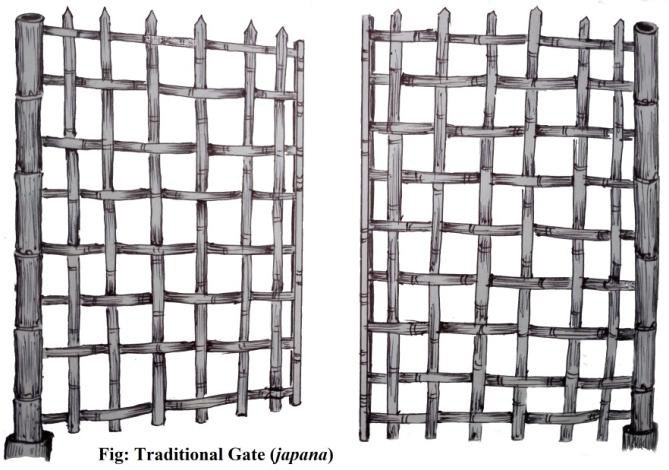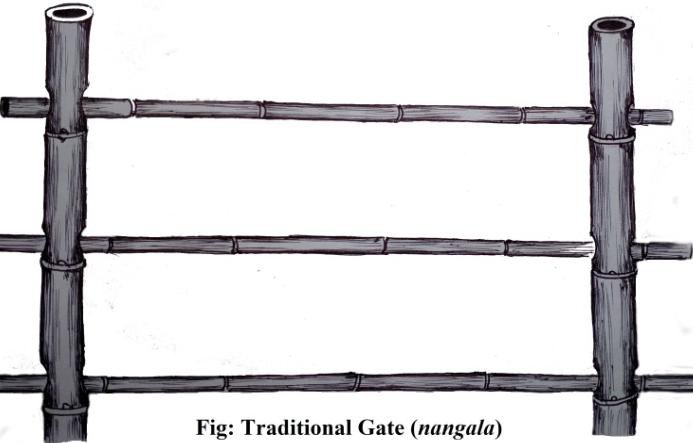Vernacular architecture of Assam
by Nabajit Deka | 2018 | 96,996 words
This study deals with the architecture of Assam (Northeastern India, Easter Himalayas), with special reference to Brahmaputra Valley. The Vernacular Architecture of Assam enjoys a variety of richness in tradition, made possible by the numerous communities and traditional cultures....
Architecture (d): Entrance Gate
 The attachment of a traditional gate at the boundary of the approach road is a usual feature of the homesteads of Assam. This gate is generally made of bamboo, using different traditional techniques and styles. The predominant variety of gate is a bamboo lath (kami) woven fence laced with pairs of kami along the borders (japana) . It may be constructed single or bi-folded, swinging or sliding type. Thus, one such variety is made swinging by fastening loosely one side of the gate to a post with a rope, which then opens through pushing the other side. Sometimes, the laced side of the fence is inserted to a bamboo capping with protruding one end, which is then inserted to a hole of another bamboo internode, embedded on the ground. This facilitates the revolving of the fence within the bamboo socket. When it is made bi-folded, the process is repeated on both the ends. In the sliding variety, the fence of the gate is opened by sliding through a gap of two inserted bamboo piece on the both end. There is another sliding variety where the gate is attached with loops or pulley at top that slides through a bamboo suspended above.
The attachment of a traditional gate at the boundary of the approach road is a usual feature of the homesteads of Assam. This gate is generally made of bamboo, using different traditional techniques and styles. The predominant variety of gate is a bamboo lath (kami) woven fence laced with pairs of kami along the borders (japana) . It may be constructed single or bi-folded, swinging or sliding type. Thus, one such variety is made swinging by fastening loosely one side of the gate to a post with a rope, which then opens through pushing the other side. Sometimes, the laced side of the fence is inserted to a bamboo capping with protruding one end, which is then inserted to a hole of another bamboo internode, embedded on the ground. This facilitates the revolving of the fence within the bamboo socket. When it is made bi-folded, the process is repeated on both the ends. In the sliding variety, the fence of the gate is opened by sliding through a gap of two inserted bamboo piece on the both end. There is another sliding variety where the gate is attached with loops or pulley at top that slides through a bamboo suspended above.
 Another traditional variety of gate is the nangala or kharkabari / salakhabari / harkala / halkala, in which few pieces of bamboo horizontally slide through holes of two installed bamboo posts to operate. For erecting such a gate, two 5-6 feet high hollow bamboo posts of bhaluka variety with long internodes are necessary. These bamboos are notched just above the nodes to make holes and to support a horizontal piece of bamboo. They are then embedded alongside the approach road and bamboo poles are passed through from one post to the other. These bamboos are slide through the holes to operate.
Another traditional variety of gate is the nangala or kharkabari / salakhabari / harkala / halkala, in which few pieces of bamboo horizontally slide through holes of two installed bamboo posts to operate. For erecting such a gate, two 5-6 feet high hollow bamboo posts of bhaluka variety with long internodes are necessary. These bamboos are notched just above the nodes to make holes and to support a horizontal piece of bamboo. They are then embedded alongside the approach road and bamboo poles are passed through from one post to the other. These bamboos are slide through the holes to operate.
The approach road is neatly fenced on both sides, usually by a special kind of fence known as shiyaltati, woven with diagonally planted kami and topped with bamboo capping. Inside this fence, the approach road is adorned with different flowering or decorative trees and bushes and few coconut trees in-between. Usually, there remains sizeable land around and beyond the approach road, where a kitchen garden is usually set up to produce varieties of vegetables for the family.
